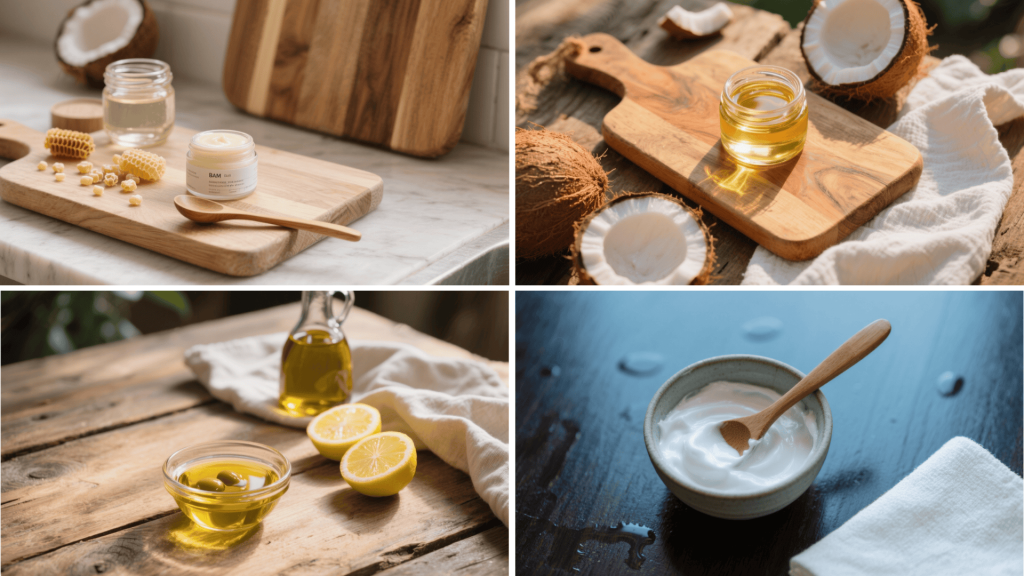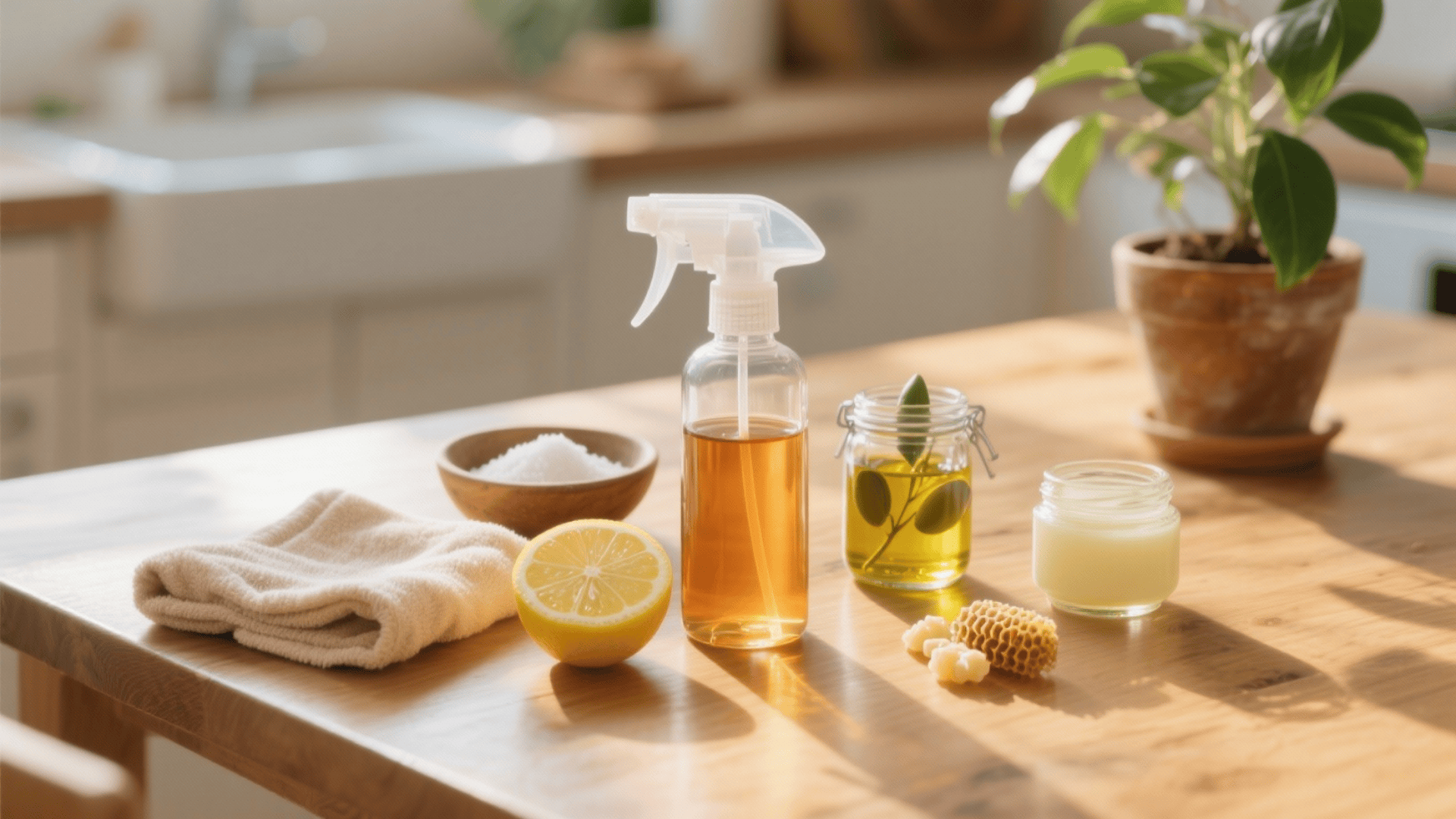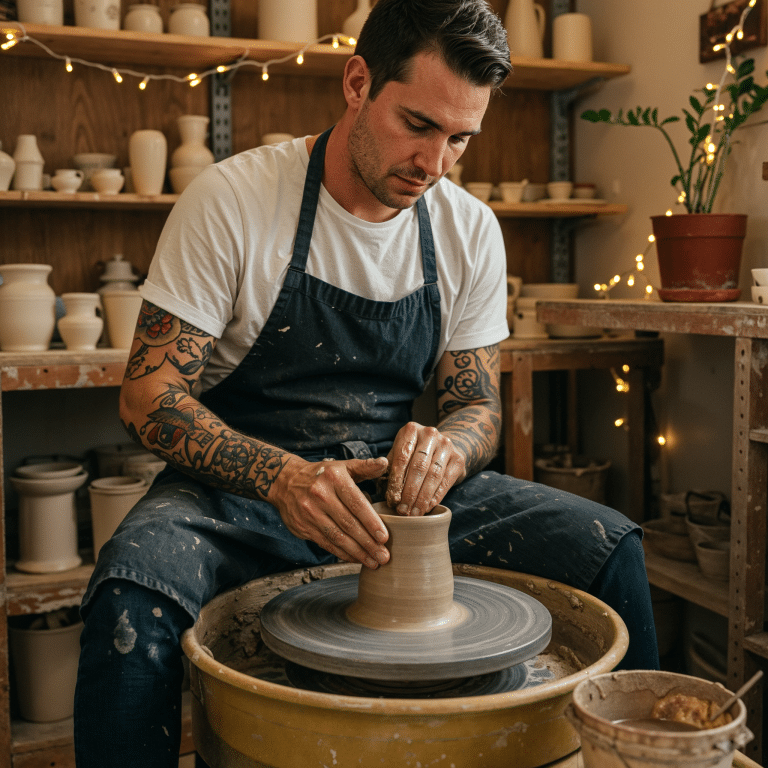Like me, you’re probably tired of chemical cleaners that irritate your skin, pollute the air, and harm the environment.
We all want a safer, healthier way to care for our homes. That’s why I switched to a natural wood cleaner—and you can too.
It’s non-toxic, eco-friendly, and safe around kids and pets, yet still leaves wood looking polished and protected.
With just a few simple household items, you can create a DIY solution that not only cleans effectively but also nourishes surfaces, keeping them beautiful for years. It’s an easy, rewarding change for a fresher, healthier home.
Benefits of Natural Wood Cleaners
Choosing a natural wood cleaner comes with more than just a beautiful shine—it also offers safer, smarter, and more sustainable benefits for your home.
- Healthier for families: Natural wood cleaners avoid harsh chemicals such as ammonia or formaldehyde, making them gentler on people with asthma, allergies, or sensitive skin.
- Safe for kids and pets: Since many DIY ingredients are food-based and non-toxic, they’re safer for households with children and animals.
- Eco-friendly choice: These cleaners break down naturally without polluting water systems, and many ingredients come with minimal packaging.
- Budget-friendly: Simple staples like vinegar and olive oil are affordable and versatile, reducing the need to buy multiple specialized products.
By switching to natural options, homeowners can enjoy cleaner wood surfaces while protecting their loved ones, their budget, and the planet.
Read This First: Finish Check & Safety
Before applying any natural wood cleaner, it is important to identify the type of finish on the wood.
A few drops of water can be used to test; if the water beads up, the wood is sealed; if it soaks in, the surface is likely unfinished and requires more care.
Sealed wood is typically safer to treat with homemade cleaners, while unsealed or antique pieces may be harmed by excess moisture or acidic ingredients such as vinegar or lemon juice.
A small hidden spot should always be tested first. Surfaces should be wiped with a damp cloth, not soaked, and dried thoroughly to preserve the wood’s natural beauty.
Best Natural Wood Cleaner Recipes

Natural wood cleaners are simple to make, cost-effective, and surprisingly powerful. With just a few household ingredients, anyone can create safe solutions that clean and protect wood while bringing out its natural shine.
1. Vinegar and Olive Oil Everyday Spray
This classic mix uses vinegar to cut through grime and olive oil to restore shine. The ingredients should be shaken before use. A light spray on a cloth is sufficient to wipe the surface, and then finish with a gentle buff.
Ingredients required:
- ½ cup white vinegar
- ¼ cup olive oil
- 1 tablespoon lemon juice
- Spray bottle, microfiber cloth
Recommended for: Sealed wood furniture and cabinets.
2. Gentle Castile Soap Dusting Spray (Vinegar-Free)
This recipe avoids vinegar, making it a mild option for sensitive finishes. The mixture is sprayed onto a cloth, not directly onto the wood, then wiped and dried to create a clean surface.
Ingredients required:
- 2 cups distilled water
- 1–2 teaspoons liquid castile soap
- Spray bottle, soft cloth
Recommended for: Regular dusting and vinegar-sensitive finishes.
3. Black Tea Tannin Cleaner
Black tea contains tannins that bring out the richness of wood. Once brewed and cooled, it can be applied with a damp cloth, wiping along the grain and drying afterward.
Ingredients required:
- 3–4 black tea bags
- 1 quart hot water
- Soft cloth or mop
Recommended for: Enhancing color and shine on sealed hardwood floors.
4. Lemon & Olive Oil Polish
This simple polish combines lemon juice and olive oil for a fresh scent and glossy finish. The mixture is applied in thin layers and buffed to restore shine.
Ingredients required:
- ½ cup olive oil
- ¼ cup lemon juice
- Few drops essential oil (optional)
- Soft cloth
Recommended for: Reviving dull or dry furniture.
5. Vinegar & Water Quick Cleaner
This simple mix is used for quick wipe-downs. It should be sprayed onto a cloth, applied to the surface, and dried promptly to avoid excess moisture.
Ingredients required:
- 1 cup white vinegar
- 1 cup distilled water
- Spray bottle
Recommended for: Fast cleaning of sealed wood surfaces.
6. Baking Soda Spot Paste
A paste made from baking soda works well on stains and water rings. It should be applied gently in circular motions, then wiped away with a cloth. Finally, the surface can be buffed to restore its smooth finish.
Ingredients required:
- 1 tablespoon baking soda
- 1 teaspoon water (or vinegar drops)
- Soft cloth
Recommended for: Water rings and stubborn surface marks.
7. Beeswax & Coconut Oil Conditioning Balm
Beeswax blended with oil creates a nourishing balm. It is rubbed sparingly onto wood, allowed to sit, then polished for a protective finish.
Ingredients required:
- 2 tablespoons beeswax pellets
- 6 tablespoons coconut or olive oil
- Heat-safe jar
Recommended for: Antique wood, butcher blocks, and wooden utensils.
8. Olive Oil & Vinegar Floor Mop Solution
This cleaner is designed for sealed hardwood floors. A light mist is applied with a spray mop, followed by immediate drying.
Ingredients required:
- 2 cups warm water
- ½ cup white vinegar
- ¼ cup olive oil
- Spray mop
Recommended for: Regular cleaning of sealed hardwood floors.
9. Coconut Oil Shine Polish
Coconut oil can be applied directly to wood for a smooth finish. A small amount is rubbed in with a cloth, left for a short time, then buffed to a gentle shine.
Ingredients required:
- 2 tablespoons coconut oil (melted if solid)
- Soft lint-free cloth
Recommended for: Cutting boards, small furniture pieces, and wooden décor.
Best Tips for Using A Natural Wood Cleaner
Keeping wood surfaces in top condition is simple when a few smart habits are followed. Natural cleaning works best when care is taken at every step.
- Dust first: Remove loose dirt before cleaning to avoid scratches.
- Spray the cloth, not the wood: Prevents over-saturation and protects the surface.
- Wipe with the grain: Maintains a smooth and polished look.
- Always dry afterward: Buff with a soft cloth to keep the shine.
- Mind the ingredients: Avoid vinegar or lemon juice on unfinished or waxed wood.
- Store properly: Use sealed bottles for liquids and jars for balms.
- Treat stains gently: Apply baking soda paste or mayonnaise for water rings.
By following these practices, homeowners can extend the life and beauty of their wood surfaces with ease.
Conclusion
Using a natural wood cleaner is one of the easiest ways to care for your furniture and floors while avoiding harsh chemicals.
With simple ingredients like vinegar, lemon juice, and natural oils, you can remove dust and grime while also conditioning the wood.
These DIY solutions are safer for children, pets, and anyone sensitive to strong odors, and they help reduce waste and environmental impact.
With regular use, your wood stays polished and protected, giving you a cleaner, healthier, and more sustainable home.







